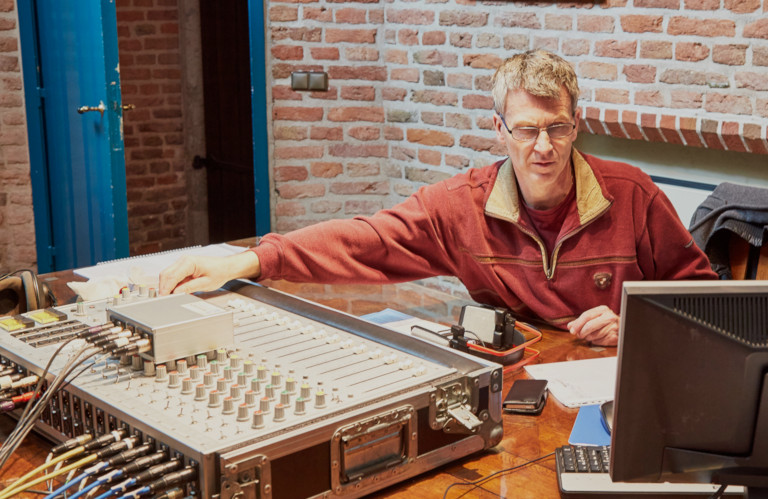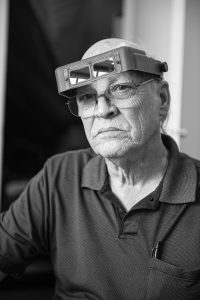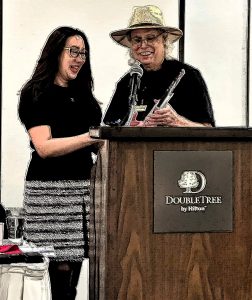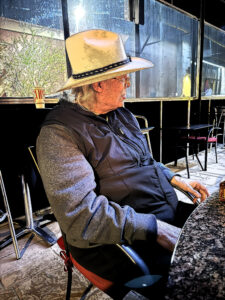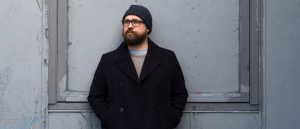You know how certain record labels become favorites that you come back to again and again? For me, it comes from a developing trust in the label and the people behind that label—it's a brand thing. I know that I'll be safe taking a chance on a new release even if I don't know the artists or the music. I trust that that the label's musical values align with mine, and I'm likely to find the new release enjoyable. Such is the case with the niche label Cobra Records founded by its chief recording and mastering engineer Tom Peeters.
I found Cobra Records because I was interested in exploring more music recorded in the binaural format. I listen entirely over headphones these days, as I've discussed in these pages previously. And, since the binaural recording format is particularly well suited for headphones listening, I wanted to hear more examples. Cobra Records is one of the few companies that offers their recordings in high resolution DSD binaural, as well as stereo and multichannel. (See my thoughts about binaural recordings, and some suggested binaural recordings from Cobra Records, HERE.)
Cobra Records works with some very good artists—mostly classical chamber music and entirely acoustic. Right down my alley! I've written in a separate article about several Cobra Records releases that I think are exceptionally good starting points for exploration (HERE), together with a discussion of the binaural recording format.
Here, I'd like to share with you my conversation with Tom Peeters in which Tom discusses his background, his goals with his record label, and his recording philosophy. Tom graciously agreed to talk with me over Skype from his studio in the Netherlands earlier this month.
Tom Peeters in the control room during a recording session with Lisa Jacobs & The String Soloists for their album Locatelli Violin Concertos, released on his Cobra Records label
RUSHTON: Tom, thanks for taking time to talk with me today. Can you start by sharing some of your background and how you came by your interest in music and making recordings?
TOM: When I entered conservatory, I thought I'd become a music teacher. But once there I learned that studies in sound recording were offered, something I'd been interested in for a long time. Since the age of 16 or 17 I spent all my money on good speakers and enjoyed listening, but always thought this would just be a hobby. That's how I approached it in conservatory—just just attending the classes in sound recording that interested me as a hobbyist.
After the first year, to go on with my studies, I had to add mathematics and physics. So finally I made this my course of study, along with becoming a music teacher. I found an internship at Channel Classics working for Jared Sacks, and this fit like a glove. I could immediately stay there following my studies at conservatory, and I did so for 5-6 years.
And, so, how did Cobra Records come about?
At Channel Classics, Jared also had a production side of his business making recordings and CDs for other companies on contract. But over time, Channel Classics grew as an independent label to the point that it was consuming the greater part of Jared's time. So, he decided to sell the third-party recording and CD production part of his company. I was one of three employees who took over this part of Channel Classics to form our own new company, Mediatrack, which continues today and is the parent for our own label, Cobra Records.
Would you tell me more about the artists you work with?
I found that there were many musicians looking for a way to get their performances recorded and produced. The major labels just had no interest in these lesser known, but still highly talented, artists. The major labels are only interested in artists who are or likely will become big names. So, there are these very talented artists who would like to make recordings of their work, but cannot get any attention from the major labels.
In the 90s people were starting to make recordings on their own, but they still needed a way to release and distribute the recordings. This was the reason for establishing Cobra Records as a label. I found there was a need for what I could do for these artists, we had the recording capability, we had the CD production and distribution capability, and they had the remarkable talent and desire to record their music.
So, for the past 10 years we've also been a label company in this very niche market. The goal for the label company is to record and release chamber music at the highest quality possible in stereo, multichannel and binaural DSD.
The majority of recordings on Cobra Records are of smaller ensembles (duos, trios, quartets) or of solo performers. What are the reasons that lead you in this direction?
Part of the reason for this comes from my interest in recording acoustic music and recording it in a natural acoustic environment. I would love to record any style of music, but I became more specialized in recording acoustical music. I look for artists who can play naturally without amplification, and can play in balance with each other. Artists who are used to performing acoustically know how to blend and coordinate together. It makes it possible to use fewer microphones, which makes for better sound. Classical performers do this naturally due to their training and what they do regularly.
Musicians coming from other genres are used to amplified sound or recording in studios with multiple microphones, where the recording engineer does all the balancing for them. This is not my style of recording. I am most interested in capturing the sound of the live performance in the performing space. I want, as much as possible, to create that perfect balance by moving my few microphones around to the precise location that will capture the sound of the room and the performers in that room, and then let the musicians create a performance.
Recording smaller ensembles is a matter of practical economics. I enjoy an opportunity to record a symphony orchestra, but the costs of setting up an orchestra recording session is simply not something a small label like Cobra can afford to do. There are so many musicians and support staff that it is very expense–far more than is possible for a small label to accomplish.
Another attraction for me is that chamber music is the most challenging for the recording engineer because there are so few instruments and these are very exposed. Unlike an orchestra, with a small ensemble the sound is very delicate, so precise, the balance is very delicate. You need to find the best musicians and then you have to be very precise in placing your microphones. Just 5-10 cm makes a difference.
When I do have the opportunity to record an orchestra, it is on a contract basis where I've been hired to make the recording for the orchestra, or hired to work with another label on a recording they may be undertaking. For example, I've spent the past week on a contract recording project for an orchestra in Rotterdam recording eight symphonies. The orchestra will be streaming these recordings in December. I enjoyed doing this work, but I could not have done this as a Cobra Records project due to the cost.
So, I do a mix of contract engagements and label projects, with my label projects typically being chamber music recordings.
How do you work with your artists?
Cobra Records is a fair trade label. Together with musicians we invest in new productions. This is for both parties a healthy mechanism that forces combining efforts for maximum publicity.
So many artists want to make a recording but have no idea what may be needed to create a recording that can generate the revenue needed to cover the costs. I find myself working more and more with artists as an advisor in addition to their producer and recording engineer.
Selling just the digital stream of recordings through someone like Spotify is not economically viable, there is no revenue stream. Even in Europe where the streaming companies can charge a subscription fee their service, the revenue may be only some small fraction of a cent for each play. But in countries where there is no subscription fee, like Indonesia, the revenue per play is 1/1000th of that or nothing at all. So, the challenge for artists today is finding alternative revenue.
I tell the artists, there must always a special story to tell about this music you wish to record. There must be some special story that creates a reason people will want to purchase your CD, a special story that will attract people to your concert, a special story that you can talk about in interviews or to your audience at the concert. Without the special story, why are you making this recording?
For example, consider The Hague String Trio's After the Darkness release. This music has a very important story behind it. They found this music and found the original manuscripts in a library. They were so impressed by finding this document and having it in their hands, they were so excited about this, it was clear they knew everything about this. So this was their identity. They could play this music but also tell the story about it in concerts and interviews. The CD was a great success for them, and they play that music in concert, and people want to hear the music and hear them talk about it. Now we will be doing their second CD, on a different topic, a different theme, but also with an important story to tell. We expect it to come out next spring.
(See my discussion of The Hague Trio's After the Darkness, HERE.)
Some of the musicians I work with are very mature, experienced artists. But, some are developing and growing. They are very good today, but they are getting better and better as they continue to perform.
One group that is exceptionally good today is Cuarteto Quiroga. I have now made four recordings with them. They are such perfectionists, always looking for how they can be better. And this makes me very nervous now because they still are asking me for advice: should this passage be louder, should we do this in this way or that way. And they want my suggestions, which motivates me to go as far as possible for the highest quality because that is the relationship we have. It is a partnership, not simply a recording project.
You cannot tell moneywise what this is worth, but it is like gold in your hands to work with artist like Cuarteto Quiroga, The Hague Trio, Lisa Jacobs, Pauline Oostenrijk... These projects are some of my most memorable experiences.
In today's COVID environment with the need for social distancing and limited gatherings, how do you see musicians surviving?
Today with COVID, it is very difficult. Most of these artists have other jobs, often for symphonies. The symphonies try to keep them busy doing other things. So, many still have some income from this. And, here in Holland, they can still perform concerts in limited capacity (30 people not 60 people). Also, they are looking for new ways to share their music via social media. Sometimes they are able to get some financial support in these ways, but often this is more a matter of continuing to share their music and connect with their audiences.
Please tell me about your recording philosophy and what you seek to accomplish in making a recording.
Of course I didn't start like this. When I started I was only recording in stereo mixed directly to two channels. This discipline of having to make recordings that sound nice right on location, mixing my microphone feeds on location direct to two track stereo, makes me very efficient today in setting up my microphones and knowing pretty well what I can expect.
Today, so many younger recordists use multi-channels figuring they will create the mix in the studio. For me, it is important to have the mix right immediately at the recording session. This adds stress but there is no reason why the technicians should not have stress as well as the performers.
Since 2007 I have added multi-channel and always record with 5 microphones. But stereo is always the most important. The stereo mix has to be perfect, and then I know how to get the surround mix once I have the stereo mix right. I'm still working on my technique for surround. For example, I've learned that my rear mics have to be closer to the front mics or there is a hole in the mix just as there will be with a stereo pair placed too far apart. And now I am learning to aim by omni mics more sideways for a more natural capture. There is always more to learn.
I have added binaural because now everybody is listening more to headphones and earbuds; music listening has become more personal listening. And adding binaural would be a way to distinguish my label.
Initially I was not considering binaural recording because all the binaural recordings that I'd heard were not that interesting to me. The sound of these recordings was simply to demonstrate the effect, not to share really good music.
But then Frank Imholz, who is in the acoustical sound treatment business, Rivasono.nl, told me I should really try binaural. He brought over to me an early Neumann Artificial (Binaural) Head recording device and said, "Here, the next time you record, try including this and see what you think."
So I did. And I found it worth continuing to experiment with. That first recording was not something I would release because the mics just didn't sound very good. But the possibilities were promising.
The technique with the binaural head is very specific because the microphones mounted in the ears of the artificial head capture every detail from all directions. Even from behind. If you compare stereo to binaural there are two big differences: 1) in binaural the position of the instruments is very clear and precise, but 2) in stereo the sound is richer but not nearly so precise.
Still, this was promising. The mics just needed to sound better. This is why I had to go to Rens Heijnis (who builds the pre-amps and mixing console I use) to get modifications made to the mics to improve the sound quality. With the original mics I had to do a lot of EQ to get them to sound better, and this is something I do not like to do because it creates other problems with the sound. With the modification Rens was able to make, now most of the time I don't have to do any EQ and I'm getting a sound I can be pleased with.
You record in DSD but must mix in DXD due to the nature of DSD. So, why not record directly to DXD?
I believe DSD has the best sound quality of which our technology is capable today. So, the philosophy behind making all the original recordings in DSD is that one day we hope to have the technology to that allows us to mix totally in DSD. When that day comes, I want to have the original DSD files that I can remix and re-release in pure DSD. I know that if I listen to the original DSD "rough" file, it is better than DXD.
So, we all have something to look forward: the time when you can remix these recordings totally in DSD and release them without the currently necessary traverse through PCM/DXD. Please keep those archived original DSD files safe.
For a further discussion of binaural recordings and some suggested albums to explore from Cobra Records, see HERE.
Tom Peeters
Photos courtesy of Tom Peeters and Cobra Records.




